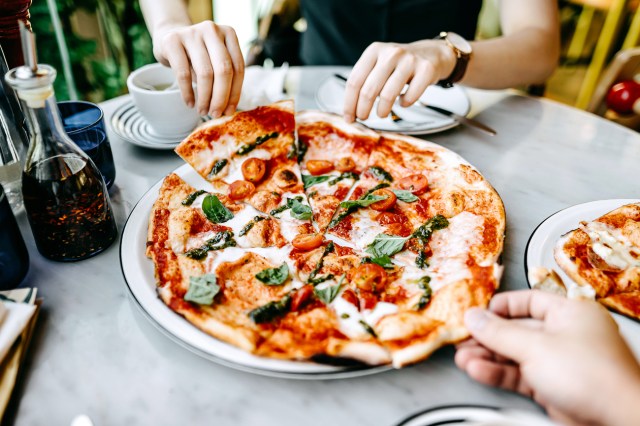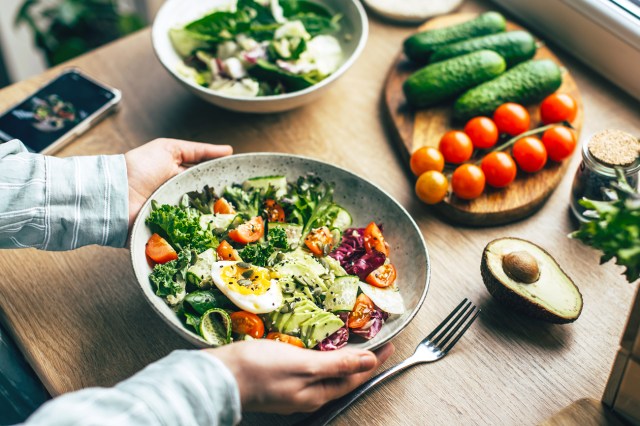If your social media pages are filled with "intuitive eating" tips, tricks, and coaches, you're not alone. The body positivity movement has transformed the way we look at and talk about our bodies, and now it's working its magic on our relationship with food. While intuitive eating may seem like the latest buzzword in our diet-obsessed culture, it's actually a philosophy that's been around for a couple of decades, introduced with the hope of freeing us from diet culture once and for all. If you're curious about intuitive eating, we're breaking down everything you need to know.

What Is Intuitive Eating?
Intuitive eating is an approach to consuming food that encourages followers to listen to their body's natural hunger and satiety cues rather than follow restrictive diets or eating schedules. This method was popularized in the 1990s by two dietitians, Evelyn Tribole, M.S., RDN, and Elyse Resch, M.S., RDN, who wrote a book titled Intuitive Eating: A Revolutionary Anti-Diet Approach. Because the approach doesn't restrict types of food or times to eat, intuitive eaters are encouraged to eat whatever foods they want without labeling said foods as "good" or "bad." The practice also advocates for eating when hungry, and stopping when full. It may be helpful for anyone who is looking to improve their relationship with food.

Is Intuitive Eating a Diet?
If weight loss is your goal, intuitive eating may not be for you. While studies show that people who eat intuitively long-term tend to have lower BMIs (body mass index) and better mental health, it's not shown to be an effective weight-loss plan. The focus instead is on being "weight-neutral" to change your relationship with food, which often leads to a healthy weight naturally without restricting, Rhonda Krick, a registered dietitian at Cedars-Sinai, explained in a 2021 report.
"If someone wants to lose weight to be healthier, I would try to understand what that means to them — possibly to lower their blood sugar or blood pressure, or have more energy — and then we would look at what behaviors that they could work on, like changing their eating habits, moving their body more, or reducing stress," Krick said. "We want to focus on tracking and shifting behavior instead of the number of the scale."

Are There Cons to Intuitive Eating?
While intuitive eating can be a great way to heal your relationship with food, depending on your health and wellness goals, it may not be the right eating plan for you. If you have a medical condition or food allergies that require careful food monitoring, it's essential to consult your doctor before making any dietary changes.
Intuitive eating also may present nutritional challenges for some people. While eating the foods you love is great, humans need certain nutrients such as vitamins, minerals, fiber, and protein to thrive. It's important to identify a variety of foods that can fit into your intuitive eating lifestyle to ensure you're eating a balanced diet that meets your body's nutritional needs. The time it takes to learn how to become in tune with your body also varies wildly from person to person. What may take some people mere weeks may take others years to master. This could lead to periods of over- or undereating while learning to listen to your body and eat intuitively.
If you've weighed the pros and cons and intuitive eating sounds right for you, we've rounded up a few tips to help you get started.
5 Tips To Help You Eat Intuitively

1. Don't Restrict Yourself
The core principle of intuitive eating is food neutrality, meaning there are no good or bad foods. All foods (yes, even Doritos) have their place in intuitive eating. When you're at the grocery store or dining out, choose foods you genuinely enjoy without attaching value to them. That goes for a "sweet treat," too. Have that cookie because you want it — not because you did something that made you think you "deserve" it.

2. Eat When You're Hungry
While this principle may seem obvious, if you're recovering from years of restrictive eating or have been ignoring your hunger cues, it can take some time to relearn how to listen to your body. Hunger cues can vary from person to person, but common signs include a drop in energy, difficulty concentrating, and an increased appetite. The key to intuitive eating is to recognize your hunger cues before you make impulsive food choices. This heightened awareness will make you feel more in tune with your body and its needs.

3. Eat Food That Makes You Feel Good
Food is fuel for our bodies, but food also plays a central part in our celebrations, how we connect with our friends and family, and how we experience new cultures and cuisines. When making decisions about your meals, consider foods that make your body feel hydrated, full of energy, and mentally clear. You should also honor your holistic needs. If sharing chips, guacamole, and margaritas with your friends honors your need to connect and celebrate, it's just as valid a food choice as a traditionally balanced meal.

4. Stop Eating When You're Full
If you're a former member of the Clean Plate Club, this one may take some time to learn. While many of us were encouraged to finish all the food on our plates even if we felt full, consistent overeating could lead to uncomfortable bloating, a dip in energy, and even feelings of illness. When you're eating, take the time to slowly chew your food and check in with yourself throughout your meal. Do you feel satisfied? Reach for seconds if your body needs it, and don't worry about finishing your food if you're full — because the only thing better than a good meal is leftovers from a good meal.

5. Pay Attention to Your Body's Mental and Physical Cues
The ultimate goal of intuitive eating is to trust yourself to make food choices that make your body and mind feel good. Paying attention to your body is the only way to know if it's working. Do you have more energy? How's your digestion? Do you feel happier? Are you sleeping well? Take the time to check in with yourself regularly, and if you need to, you can tweak your approach to eating to honor your body and mind.
This article is for general informational purposes only.
Affiliate Disclaimer Medical Disclaimer















 Unique Beauty is free for all users.
Unique Beauty is free for all users.